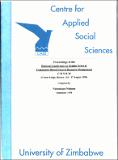| dc.contributor.author | Dube, Julia | |
| dc.contributor.author | Maphosa, Regina | |
| dc.contributor.author | Mlotshwa, Gladys | |
| dc.coverage.spatial | Zimbabwe. | en |
| dc.date.accessioned | 2016-03-23T16:09:18Z | |
| dc.date.available | 2016-03-23T16:09:18Z | |
| dc.date.issued | 1998-09 | |
| dc.identifier.citation | Dube, J., Maphosa, R. and Mlotshwa, G. (1998) Voices from the village: local perspectives on the empowerment of women through CBNRM in Tsholotsho District, Zimbabwe. In: Nabane, N. (ed.) Proceedings of the Regional Conference on Gender Issues in Communitv-Based Natural Resource Management CBNRM (Cresta Lodge, Harare : 24 - 27 August 1998). Harare: CASS, pp. 113-117. | en |
| dc.identifier.uri | https://opendocs.ids.ac.uk/opendocs/handle/20.500.12413/10260 | |
| dc.description | A symposium paper on gender participation in rural development through the programme CBNRM in one of Zimbabwe's rural areas of Tsholotsho. | en |
| dc.description.abstract | Tsholotsho has 20 wards, 20 Councillors composed of one woman, one white man and 18 black men. The woman is the Councillor for Ward 7, which is the focus of the paper. The Ward has a population of 8 191 with 650 San Khois and the rest of them are Ndebeles. The San Khois are the minority ethnic group in Tsholotsho and are marginalised. There have been certain projects targeted at these people. When the Ndebele came to the District in 1953, the San Khois were already settled in area. These Ndebele people were moved from Matopo during the colonial era when the land that they occupied was gazetted for commercial fanning purposes. These San Khois were hunters and gatherers, meaning that they relied on the forest for livelihood, whereas the Ndebele were pastoralists/ agriculturists.
There was a lot of vegetation in the areas that they lived in because they did not use trees. The problem that was encountered when the Ndebele moved to Tsholotsho is that it took time for the two groups to integrate because they were both afraid to meet each other and relate closely. | en |
| dc.description.sponsorship | The success of this conference and the publication of these proceedings has been possible through support from the US Agency for International Development (USAID) | en |
| dc.language.iso | en | en |
| dc.publisher | Centre for Applied Social Sciences (CASS); University of Zimbabwe (UZ) | en |
| dc.relation.ispartofseries | CASS Occasional Paper - NRM Series;;CPN. 97/98 | |
| dc.rights.uri | http://creativecommons.org/licenses/by-nc-nd/3.0/ | en |
| dc.subject | Gender | en |
| dc.subject | Rural Development | en |
| dc.title | Voices from the village: local perspectives on the empowerment of women through CBNRM in Tsholotsho District, Zimbabwe | en |
| dc.type | Conference paper | en |
| dc.rights.holder | University of Zimbabwe (UZ) | en |


